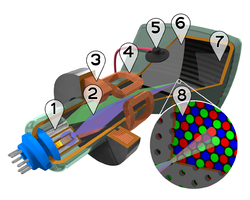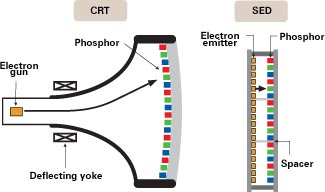Cathode Ray Tube Technology (CRT)
CRT is an analog device that is utilized by a digital device - computer. In this section, the interface among these two devices is explained. The major components of CRT are given below :
Electron Gun
It generates a narrow beam of electrons (cathode rays) which pass through the focusing and deflection systems.
Focusing System
It generates a non-blurred picture by focusing the electrons of the cathode ray into a narrow beam.
Deflection System
Deflection directs the beam towards particular positions on the phosphor-coated screen.
Phosphor-coated Screen
This screen emits a small spot of light at each location contacted by the cathode ray.

CRT is considered to be one of the most significant components because the quality of displayed image influences the perception of generated design on the CAD/CAM systems. It enables the user to communicate by manipulating distinct entities on the screen. Many display technologies are now available. Among the available technologies CRT is the most dominating.
Working
The electron beam generates a tiny, bright visible spot while it strikes the phosphor-coated screen. A colour CRT monitor contains three different coloured phosphors arranged in triangular groups called triads. Each triad consists of three phosphors of colours - red, green and blue. So there are three electron guns - one for the primary colour red, one for the primary colour green, and one for the primary colour blue, each of which produced an electron beam to excite one of the phosphor dots. The CRT, thus, produces three overlapping images : one in red (R), one in green (G) and one in blue (B). It is the so-called RGB colour model. In order to ensure that an electron beam activates only phosphors of proper colour, a metal grid called as shadow mask is utilized as shown in Figure.
Different coloured light is produced at the screen position hit by the electron beam according to the phosphor type, which fades rapidly in 10 to 60 microseconds. Fading time depends on the persistence (the time from the elimination of the excitation to the moment when phospherescence has decayed to 10% of the initial light output) of phosphor coated inside the screen. In order to ignore flickering picture should be kept on the screen for a while, the picture must be redrawn before it disappears off the screen. This is called refreshing of the screen.

One may imagine the CRT screen as a two-dimensional matrix that has m rows and n columns and this is usually referred as raster. Each row of the m rows (or the points on a horizontal line of the screen) is called as scan-line. The number of points that may be displayed on the screen (n × m) is defined as the resolution of the screen. The resolution is related to the size of the point that emits light after the contact of the electron beam. Displays can be divided into random and raster scan displays. They are explained in details below.